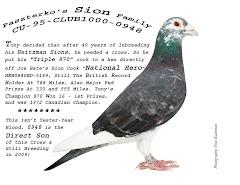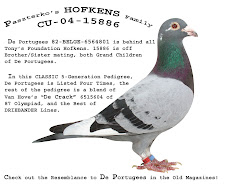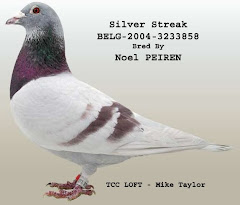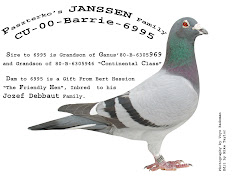By Jas. C. Foster, Jr.
The American Racing Pigeon News
September, 1954
We hear much about methods of training pigeons. "I fly my pigeons forty miles every day;" "I force fly them thirty minutes around the loft every morning," and so on. How about it? What is the right method, or is there such a thing as a good method; a satisfactory system for conditioning racing pigeons? Personally, I do not think there is.
The baseball season is now well under way. Presumably all regular players are in as good condition as it has been possible to get them. How did they get that way?
Sometime ago, after the winter layoff, they all were called in to the spring training camps. Individually, they were in very different states of physical condition. Did the managers put them all through the same course of training? Certainly not.
Some were overweight, gross and sluggish. Nothing but long hours of hard work would take off the excess fat and put them into condition. They got this work, day after day. Others were underweight and too fine. Some had had operations or illnesses from which they had fully recovered. Did these men get the same conditioning treatment as the fat and sluggish players. Certainly not. They had to be built up and brought into work slowly as they toughened up and could take it.
I do not think there are greater differences in physical condition between ball players or race horses than between racing pigeons. Nor do I think there are greater differences between the same number of racing pigeons.
It would sound rather silly, wouldn't it, to ask a trainer how much work he gives his race horses to put them in racing trim. Some horses take several times as much work as others. In fact, both work and diet must be fitted to the needs of individual horses or there would be no hope of ever winning a Kentucky Derby. The work one horse may need to put it into condition would kill off another horse altogether.
It is the same way with racing pigeons. There can't be any system suitable for all of them. Different pigeons require very different amounts of work. They all, of course, need some work. They may be started off together and given calisthenics up to, say, 100 miles. Then the way each individual pigeon takes its work and reacts to it must be studied carefully. After the calisthenics stages are past, the work given to each individual pigeon must be regulated to meet its individual needs.
Racing pigeons should be conditioned as individuals, which they are, not as a flock. I do not think there is, nor can be, any successful "system" for training racing pigeons; one that will be suitable to all individuals of any race team. I think each racing pigeon must be treated as an individual and trained and conditioned as an individual. Any fancier who relies upon a "system" of training is very apt to find that this system fits only a small percentage of his race team and that the rest of the team never come into high racing form. As challengers for the top honors, the rest of these pigeons are useless, although many of them may potentially be among the best racers of the team.
The fancier who thinks of his pigeons as so many race horses and attempts to handle each one so as to meet its individual needs is the fancier most likely to ship an entry of pigeons to a race in such condition that each one will have a real opportunity to offer top contention. Unfit pigeons don't win. No matter how good any system may be, it will not fit the needs of most of the pigeons in any team, nor will it bring them into top racing form.














